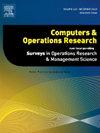闭环供应链中高科技产品回收方案的优化
IF 4.3
2区 工程技术
Q2 COMPUTER SCIENCE, INTERDISCIPLINARY APPLICATIONS
引用次数: 0
摘要
频繁的产品开发是消费电子行业缩短产品生命周期的一种解决方案。它使公司保持竞争力,加强市场份额。然而,环境问题使逆向物流实践成为焦点。回收政策是一种战略性的逆向物流活动,以提高市场份额;然而,这也带来了各种挑战和不确定性。考虑到不确定的需求,我们引入了一种具有两种不同回收政策的创新采用模型,即以旧换新和信贷,以解决多代生产计划中的挑战。受苹果和三星等公司现实实践的启发,我们的模型首先研究了以旧换新计划如何推动重复购买和提高市场份额,并利用基于信用的计划吸引新客户。然后,它捕获需求、生产计划、恢复决策和多代产品之间的内部竞争的变化。与之前的结论不同,本研究探讨了生产商如何从战略上管理对新一代产品的需求,以减缓扩散,从而随着时间的推移增加翻新和回收量。我们的研究结果强调了适应性定价策略和生产可扩展性在竞争激烈的高科技产业中最大化盈利能力和促进可持续性方面的关键作用。本文章由计算机程序翻译,如有差异,请以英文原文为准。
Optimizing high-tech product take-back schemes in a closed-loop supply chain
Frequent product development is a solution to the shortened product lifecycles in the consumer electronics industry. It enables companies to maintain competitiveness and strengthen their market share. However, environmental concerns bring reverse logistics practices into focus. A take-back policy is a strategic reverse logistics activity known to foster market share; however, it poses various challenges and uncertainties. Considering uncertain demand, we introduced an innovative adoption model with two distinct take-back policies, trade-in and credit, to address challenges in multi-generation production planning. Inspired by real-world practices of companies like Apple and Samsung, our model first examines how trade-in programs drive repeat purchases and enhance market share, with credit-based programs to attract new customers. It then captures changes in demand, production planning, recovery decisions, and internal competition among multiple product generations. Distinct from previous conclusions, this study explores how producers can strategically manage demand for new generations to slow diffusion, thereby increasing refurbishment and recycling volumes over time. Our findings highlight the pivotal role of adaptive pricing strategies and production scalability in maximizing profitability and promoting sustainability in competitive high-tech industries.
求助全文
通过发布文献求助,成功后即可免费获取论文全文。
去求助
来源期刊

Computers & Operations Research
工程技术-工程:工业
CiteScore
8.60
自引率
8.70%
发文量
292
审稿时长
8.5 months
期刊介绍:
Operations research and computers meet in a large number of scientific fields, many of which are of vital current concern to our troubled society. These include, among others, ecology, transportation, safety, reliability, urban planning, economics, inventory control, investment strategy and logistics (including reverse logistics). Computers & Operations Research provides an international forum for the application of computers and operations research techniques to problems in these and related fields.
 求助内容:
求助内容: 应助结果提醒方式:
应助结果提醒方式:


